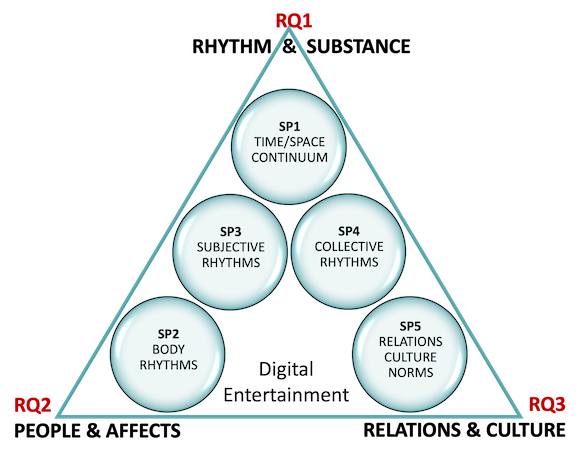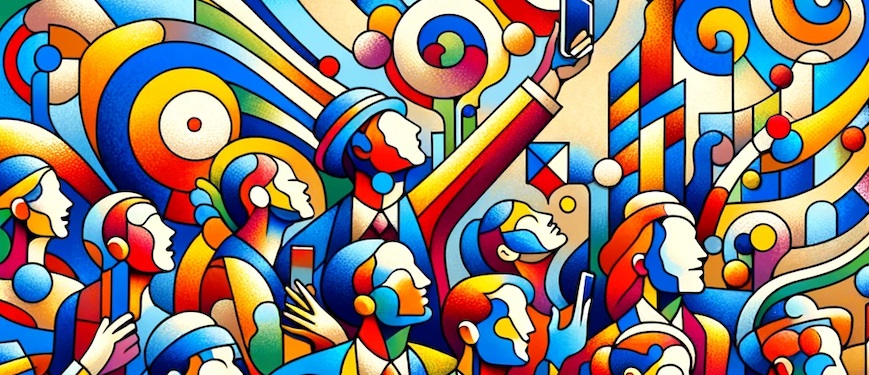Background and idea
Before digital media, entertainment belonged to clearly-delimited leisure time and spaces that we usually shared with others, like the coffee shop, the festival, the cinema or the couch in front of the television (Zerlang 1989; Dyer 1992). Now, we can be entertained everywhere, at any time, filling all the crevices of our everyday life with entertainment, alone or networked with distant others in increasingly personalized media consumption practices (Livingstone 2007). Positive emotions are only just a click away (Bryant & Vorderer 2006). Even "serious" media content like news and politics are shaped in entertaining ways and feed memes that are widely shared through digital media (Van Zoonen 2005; Nærland 2018).
DiEM argues that digital entertainment has become an omnipresent force that shapes the rhythms and substance of our everyday life. Its goal is to understand how ubiquitous digital entertainment influences us and to map the emerging entanglements of subjects, technologies, affect, culture and ideas. Our hypothesis is that the boundaries between escapism and purposeful activities, such as creating and maintaining social connections through shared experiences or co-play have become fluid. DiEM will contribute to the body of research by providing a synthesis of hitherto separate approaches and expanding upon them.
Digital entertainment
We propose an updated definition of digital entertainment as the purposeful engagement of our attention using digital technologies in order to elicit pleasure and/or relief in our everyday life. Entertainment situations are user-directed, as people navigate an environment of affordances (Costall, 1995; Bucher & Helmond, 2018) choosing different platforms according to their personal interests and needs. DiEM thus sees digital entertainment as a form for polymedia (Madianou and Miller 2012), since users compensate for the limitations and shortcomings of individual platforms by combining and shuffling between them (Madianou 2016).
In our project, we investigate how purposefulness can co-exist with distraction, as the mobile phone becomes a transitional object providing relief in moments of in-between-ness (Mowlabocus, 2016). The entertained subject, always-on-everywhere, shifts between degrees of activity and passivity, commercial and user-produced content, private and public spheres, intimate and social orientations.
The always on-everywhere entertained subject relates to others in novel ways that have the potential to transform and disrupt traditional social and cultural norms.
Research questions
1. How does digital entertainment shape the rhythms and substance of everyday life?
2. How do people manage and evaluate their entertainment life and what affects emerge?
3. How does digital entertainment affect our relations with other people, transforming social and cultural norms?

Methodological approach
DiEM is a media studies project, inspired by Lefebvrian rhythmanalysis, that uses a hybrid multi- method approach: qualitative interviews, digital methods, ethnography (also digital ethnography), aesthetic analysis as well as arts-based methods.
The first step of our data collection is an interview pilot study conducted by all team members to establish a basic understanding of the role of digital entertainment in people’s lives.
The project builds its conceptual insights on the empirical research of four subprojects, which explore digital entertainment from different angles.
In the final stages of the project, findings will be explored together with audiences via arts-based methods.
Subprojects
SP1- Reconfiguring Escapism (ST & EM)
SP1 will focus on how entertainment is woven through the time-space continuum of everyday life. People combine the linear rhythms of production and survival (work, study, domestic life) with cyclical rhythms of digital entertainment in polyrhythmic assemblages.
Cases: everyday entanglements (EM), reel videos (ST)
SP2- Embodied Rhythms (LYN)
SP2 will explore the embodied, intimate, and sensorial use of digital entertainment, where rhythm is felt, but often not entirely known. The body is a crucial tool in rhythmanalysis, as the mobile becomes a channel for intimacy, proximity, affect, pleasure, and comfort.
Cases: Oddly satisfying, sleep streams
SP3- Simultaneous Engagements and Disengagements (EC & EM)
The subproject's goal is to explore the fluid space between playfulness, purposeful activities and mood regulation that emerges in our intensive everyday engagement with digital media.
Cases: music for well-being (EC), disruptions and disentanglements (EM)
SP4- Collective Rhythms (ST & EC & EM + research assistants)
The subproject's object of study is the collective rhythms that infiltrate individual feeds, shaped by the material specificities of each platform. Algorithmic content curation produces collective rituals we can be a part of, creating a culture of collective, iterative remixing that constantly produces new content.
Case: mapping of collective trends across platforms.
SP5- Museum of Entertainment (all)
SP5 builds upon a series of workshop engagements in the public sphere to iteratively investigate people ́s own self-understanding of their own digital entertainment entanglements and how they are punctuated by norm-ridden reflections (Hochschild, 2003) in their own social and cultural life.
Case: arts-based interventions with the public.
Selected literature
Bryant, J. & Vorderer P. (2006). Psychology of Entertainment. Mahway, N.J: Lawrence Erlbaum.
Bucher, T., & Helmond, A. (2018). "The Affordances of Social Media Platforms". In J. Burgess, A. Marwick, & T. Poell (Eds.), The SAGE Handbook of Social Media. London: Sage Publications.
Costall, A. (1995). "Socializing Affordances". Theory & Psychology, 5(4), 467–481. Couldry, N. (2012). Media, society, world, social theory and digital media practice. Cambridge: Polity.
Dyer, R. (2002). Only entertainment. London/New York: Routledge.
Lefebvre, H. (1992). 2004. Rhythmanalysis: Space, Time and Everyday Life. London: Continuum.
Livingstone, S. (2007). "From family television to bedroom culture: Young people's media at home". In Devereux, E. (edit.). Media studies: key issues and debates. London: SAGE.
Lyon, D. (2020). Rhythmanalysis: Research Methods. London: Bloomsbury Publishing Plc.
Madianou, M., & Miller, D. (2012). Migration and new media: transnational families and polymedia. London/New York: Routledge.
Madianou, M. (2016). "Ambient co-presence: transnational family practices in polymedia environments". Global Networks (Oxford), 16 (2), 183–201.
Mowlabocus, S. (2016). "The ’mastery’ of the swipe: Smartphones, transitional objects and interstitial time". First Monday, 21(10).
Nærland, T. U. (2018). "Fictional entertainment and public connection: audiences and the everyday use of TV-series". Television & New Media 20: 651–669.
Van Zoonen, L. (2005). Entertaining the Citizen: When Politics and Popular Culture Converge. Lanham, MD: Rowman & Littlefield.
Zerlang, M. (1989). Underholdningens Historie. Fra antikkens gladiatorer til nutidens TV serier. København: Gyldendal.
